Report: Public Health and Ethiopian Women Empowerment
VerifiedAdded on 2019/09/24
|10
|2390
|393
Report
AI Summary
This report provides an in-depth analysis of the challenges and strategies related to empowering Ethiopian women within the context of public health. It begins with an introduction highlighting the poverty and gender disparities prevalent in Ethiopia, including high illiteracy rates and early marriage practices. The report then delves into the background of Ethiopian women's situation, focusing on health issues such as high child mortality rates, malnutrition, and harmful traditional practices like female genital mutilation and kidnapping. It also addresses the impact of rape, polygamy, and the spread of HIV/AIDS. The core of the report examines the approaches and strategies undertaken by the Ethiopian government to empower women, including the establishment of the Women's Affairs Office and the implementation of the National Policy on Women. The report further details the roles of various organizations such as the Police, Prosecution Department, Women’s Bureau, Kebele Administration, and Technology Research Centers that work to address violence, promote legal rights, coordinate gender-related actions, and provide financial and technological support. The conclusion emphasizes the ongoing challenges in achieving gender equality and highlights the government’s efforts to address these issues through policy frameworks and collaborations with NGOs and women's organizations.
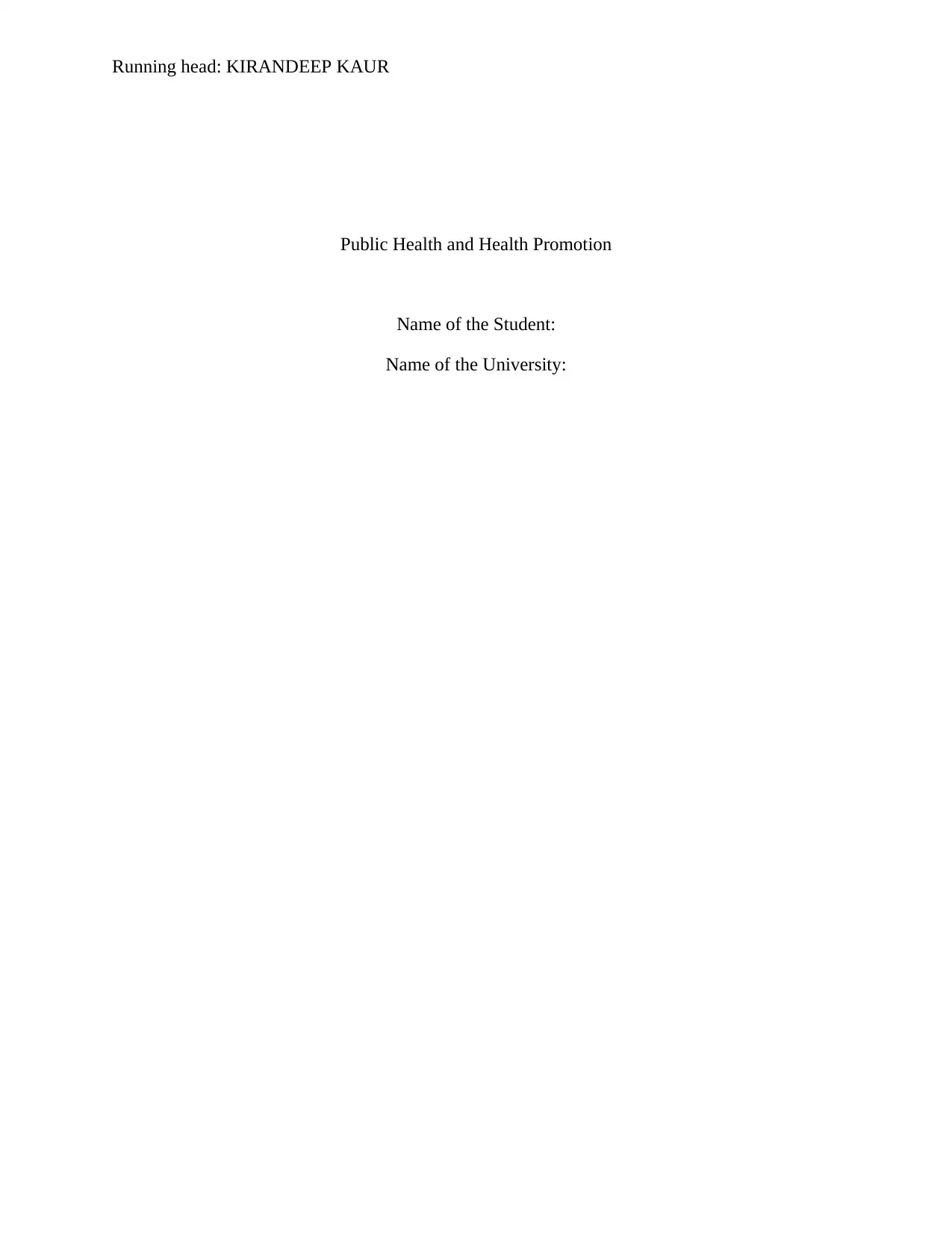
Running head: KIRANDEEP KAUR
Public Health and Health Promotion
Name of the Student:
Name of the University:
Public Health and Health Promotion
Name of the Student:
Name of the University:
Paraphrase This Document
Need a fresh take? Get an instant paraphrase of this document with our AI Paraphraser
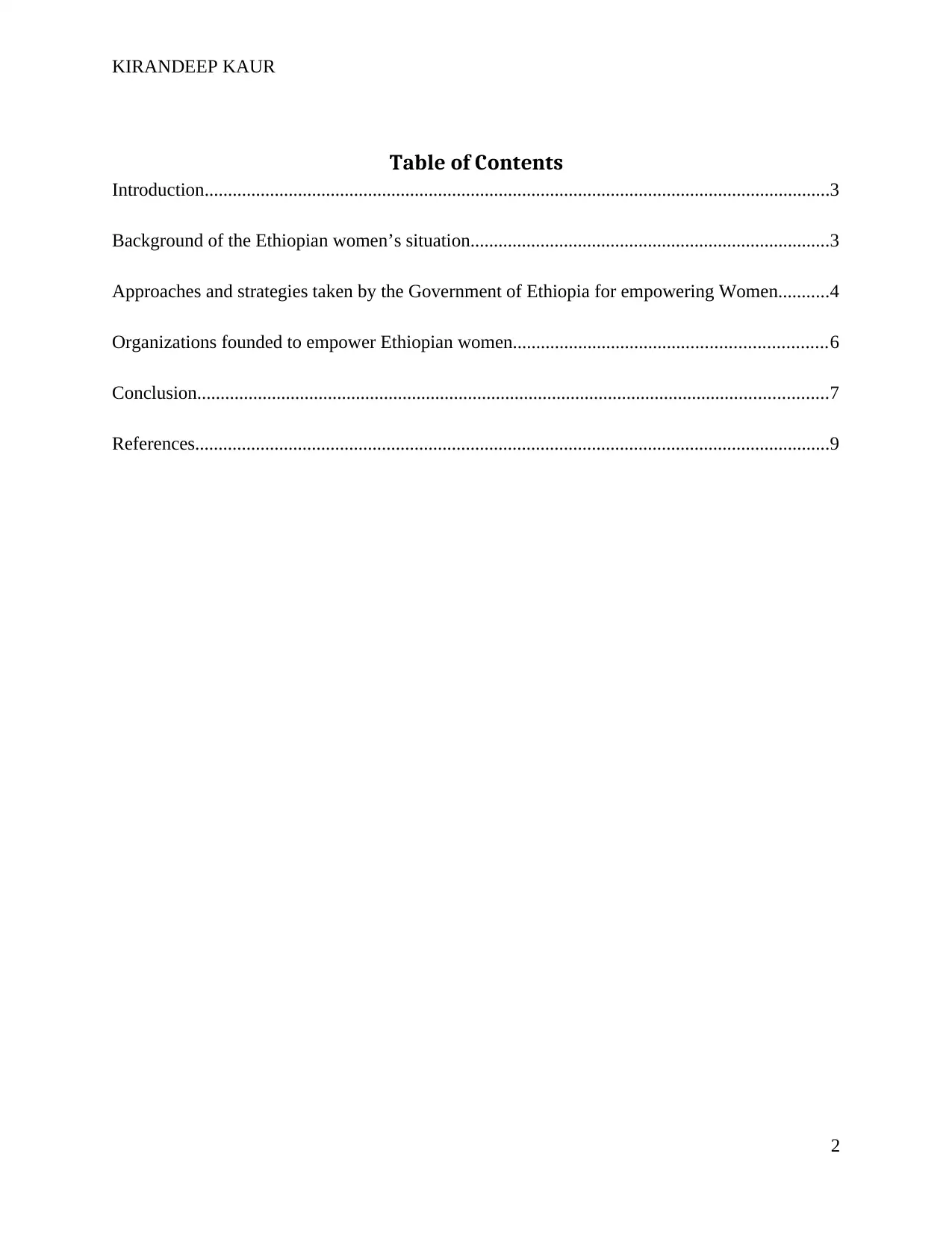
KIRANDEEP KAUR
Table of Contents
Introduction......................................................................................................................................3
Background of the Ethiopian women’s situation.............................................................................3
Approaches and strategies taken by the Government of Ethiopia for empowering Women...........4
Organizations founded to empower Ethiopian women...................................................................6
Conclusion.......................................................................................................................................7
References........................................................................................................................................9
2
Table of Contents
Introduction......................................................................................................................................3
Background of the Ethiopian women’s situation.............................................................................3
Approaches and strategies taken by the Government of Ethiopia for empowering Women...........4
Organizations founded to empower Ethiopian women...................................................................6
Conclusion.......................................................................................................................................7
References........................................................................................................................................9
2
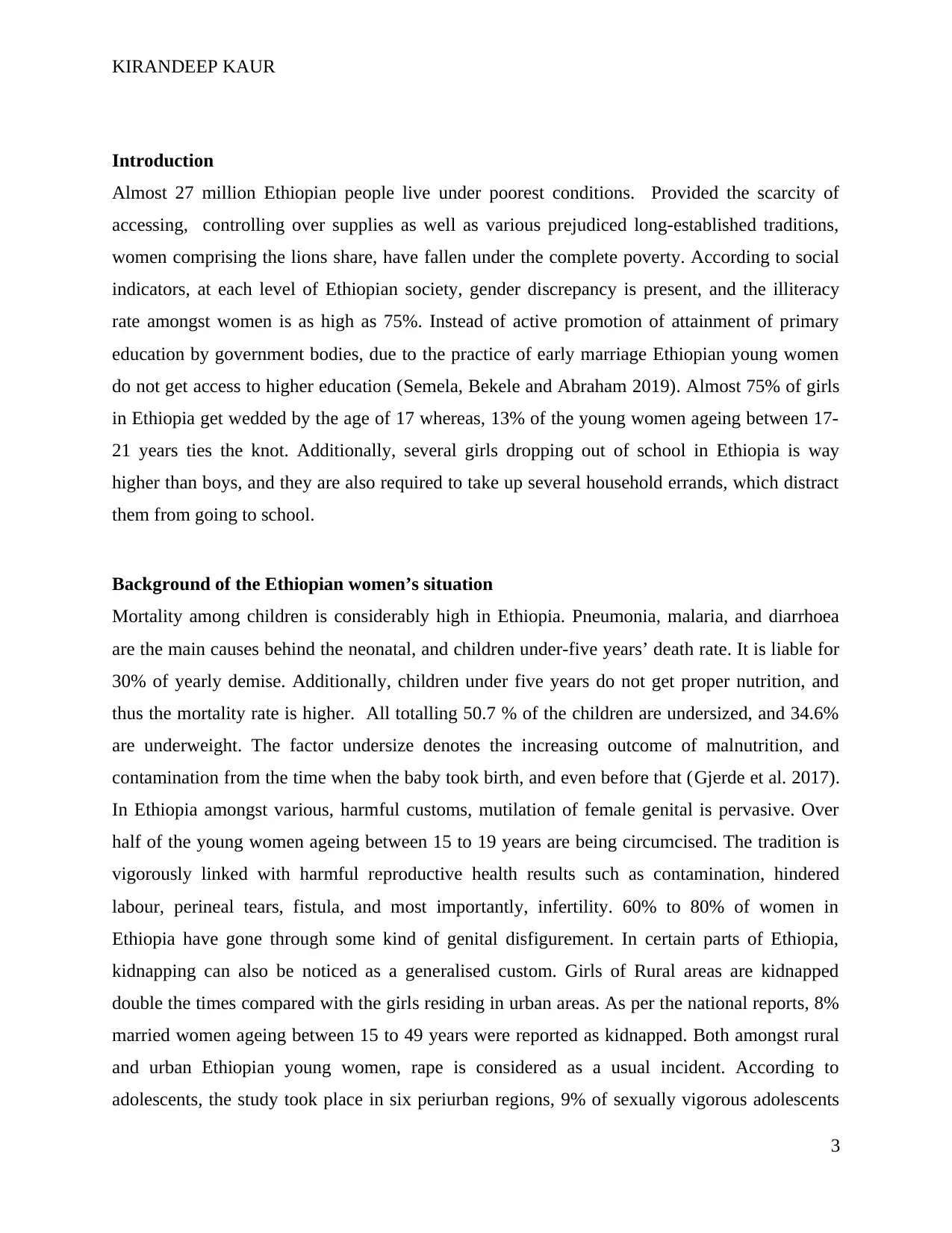
KIRANDEEP KAUR
Introduction
Almost 27 million Ethiopian people live under poorest conditions. Provided the scarcity of
accessing, controlling over supplies as well as various prejudiced long-established traditions,
women comprising the lions share, have fallen under the complete poverty. According to social
indicators, at each level of Ethiopian society, gender discrepancy is present, and the illiteracy
rate amongst women is as high as 75%. Instead of active promotion of attainment of primary
education by government bodies, due to the practice of early marriage Ethiopian young women
do not get access to higher education (Semela, Bekele and Abraham 2019). Almost 75% of girls
in Ethiopia get wedded by the age of 17 whereas, 13% of the young women ageing between 17-
21 years ties the knot. Additionally, several girls dropping out of school in Ethiopia is way
higher than boys, and they are also required to take up several household errands, which distract
them from going to school.
Background of the Ethiopian women’s situation
Mortality among children is considerably high in Ethiopia. Pneumonia, malaria, and diarrhoea
are the main causes behind the neonatal, and children under-five years’ death rate. It is liable for
30% of yearly demise. Additionally, children under five years do not get proper nutrition, and
thus the mortality rate is higher. All totalling 50.7 % of the children are undersized, and 34.6%
are underweight. The factor undersize denotes the increasing outcome of malnutrition, and
contamination from the time when the baby took birth, and even before that (Gjerde et al. 2017).
In Ethiopia amongst various, harmful customs, mutilation of female genital is pervasive. Over
half of the young women ageing between 15 to 19 years are being circumcised. The tradition is
vigorously linked with harmful reproductive health results such as contamination, hindered
labour, perineal tears, fistula, and most importantly, infertility. 60% to 80% of women in
Ethiopia have gone through some kind of genital disfigurement. In certain parts of Ethiopia,
kidnapping can also be noticed as a generalised custom. Girls of Rural areas are kidnapped
double the times compared with the girls residing in urban areas. As per the national reports, 8%
married women ageing between 15 to 49 years were reported as kidnapped. Both amongst rural
and urban Ethiopian young women, rape is considered as a usual incident. According to
adolescents, the study took place in six periurban regions, 9% of sexually vigorous adolescents
3
Introduction
Almost 27 million Ethiopian people live under poorest conditions. Provided the scarcity of
accessing, controlling over supplies as well as various prejudiced long-established traditions,
women comprising the lions share, have fallen under the complete poverty. According to social
indicators, at each level of Ethiopian society, gender discrepancy is present, and the illiteracy
rate amongst women is as high as 75%. Instead of active promotion of attainment of primary
education by government bodies, due to the practice of early marriage Ethiopian young women
do not get access to higher education (Semela, Bekele and Abraham 2019). Almost 75% of girls
in Ethiopia get wedded by the age of 17 whereas, 13% of the young women ageing between 17-
21 years ties the knot. Additionally, several girls dropping out of school in Ethiopia is way
higher than boys, and they are also required to take up several household errands, which distract
them from going to school.
Background of the Ethiopian women’s situation
Mortality among children is considerably high in Ethiopia. Pneumonia, malaria, and diarrhoea
are the main causes behind the neonatal, and children under-five years’ death rate. It is liable for
30% of yearly demise. Additionally, children under five years do not get proper nutrition, and
thus the mortality rate is higher. All totalling 50.7 % of the children are undersized, and 34.6%
are underweight. The factor undersize denotes the increasing outcome of malnutrition, and
contamination from the time when the baby took birth, and even before that (Gjerde et al. 2017).
In Ethiopia amongst various, harmful customs, mutilation of female genital is pervasive. Over
half of the young women ageing between 15 to 19 years are being circumcised. The tradition is
vigorously linked with harmful reproductive health results such as contamination, hindered
labour, perineal tears, fistula, and most importantly, infertility. 60% to 80% of women in
Ethiopia have gone through some kind of genital disfigurement. In certain parts of Ethiopia,
kidnapping can also be noticed as a generalised custom. Girls of Rural areas are kidnapped
double the times compared with the girls residing in urban areas. As per the national reports, 8%
married women ageing between 15 to 49 years were reported as kidnapped. Both amongst rural
and urban Ethiopian young women, rape is considered as a usual incident. According to
adolescents, the study took place in six periurban regions, 9% of sexually vigorous adolescents
3
⊘ This is a preview!⊘
Do you want full access?
Subscribe today to unlock all pages.

Trusted by 1+ million students worldwide
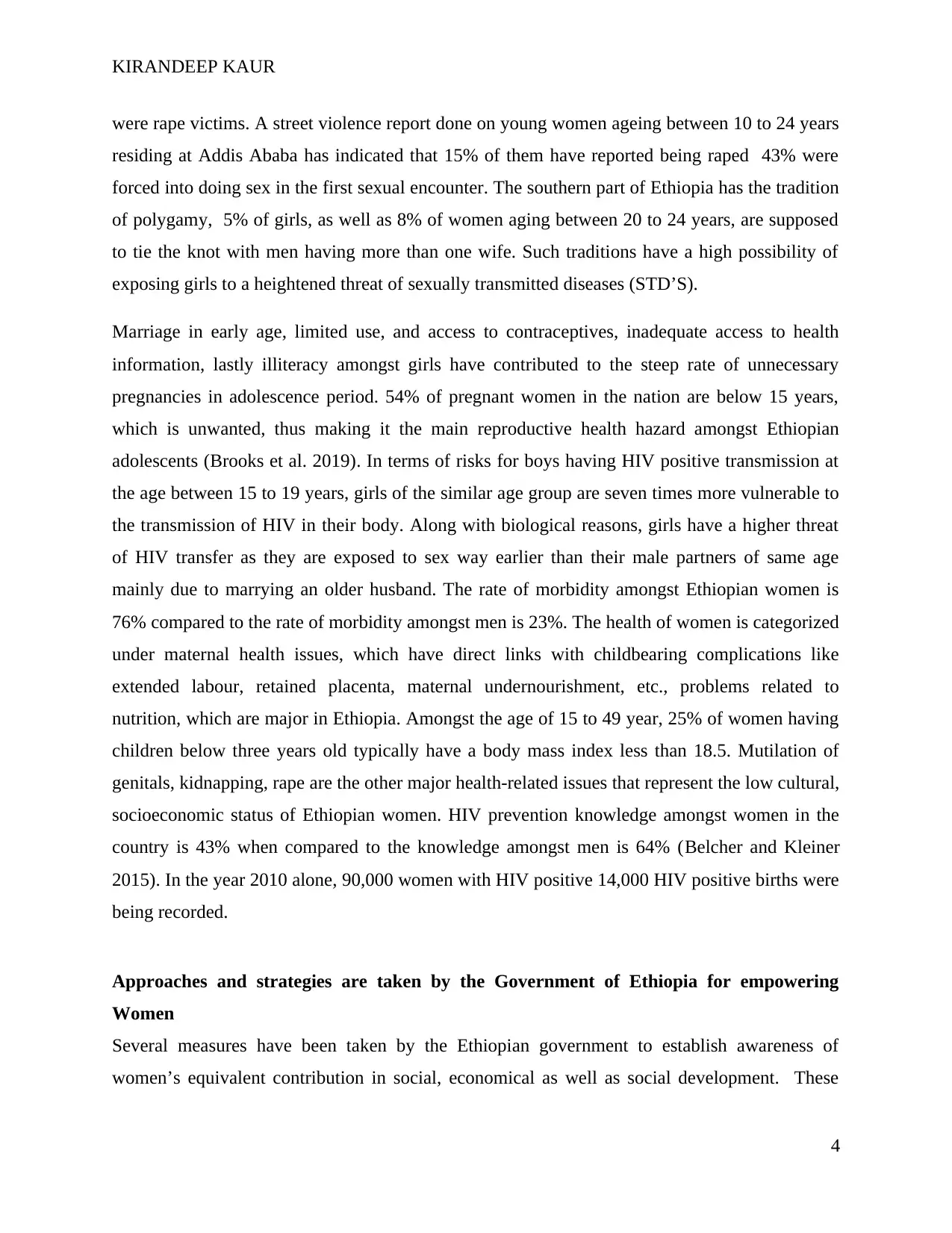
KIRANDEEP KAUR
were rape victims. A street violence report done on young women ageing between 10 to 24 years
residing at Addis Ababa has indicated that 15% of them have reported being raped 43% were
forced into doing sex in the first sexual encounter. The southern part of Ethiopia has the tradition
of polygamy, 5% of girls, as well as 8% of women aging between 20 to 24 years, are supposed
to tie the knot with men having more than one wife. Such traditions have a high possibility of
exposing girls to a heightened threat of sexually transmitted diseases (STD’S).
Marriage in early age, limited use, and access to contraceptives, inadequate access to health
information, lastly illiteracy amongst girls have contributed to the steep rate of unnecessary
pregnancies in adolescence period. 54% of pregnant women in the nation are below 15 years,
which is unwanted, thus making it the main reproductive health hazard amongst Ethiopian
adolescents (Brooks et al. 2019). In terms of risks for boys having HIV positive transmission at
the age between 15 to 19 years, girls of the similar age group are seven times more vulnerable to
the transmission of HIV in their body. Along with biological reasons, girls have a higher threat
of HIV transfer as they are exposed to sex way earlier than their male partners of same age
mainly due to marrying an older husband. The rate of morbidity amongst Ethiopian women is
76% compared to the rate of morbidity amongst men is 23%. The health of women is categorized
under maternal health issues, which have direct links with childbearing complications like
extended labour, retained placenta, maternal undernourishment, etc., problems related to
nutrition, which are major in Ethiopia. Amongst the age of 15 to 49 year, 25% of women having
children below three years old typically have a body mass index less than 18.5. Mutilation of
genitals, kidnapping, rape are the other major health-related issues that represent the low cultural,
socioeconomic status of Ethiopian women. HIV prevention knowledge amongst women in the
country is 43% when compared to the knowledge amongst men is 64% (Belcher and Kleiner
2015). In the year 2010 alone, 90,000 women with HIV positive 14,000 HIV positive births were
being recorded.
Approaches and strategies are taken by the Government of Ethiopia for empowering
Women
Several measures have been taken by the Ethiopian government to establish awareness of
women’s equivalent contribution in social, economical as well as social development. These
4
were rape victims. A street violence report done on young women ageing between 10 to 24 years
residing at Addis Ababa has indicated that 15% of them have reported being raped 43% were
forced into doing sex in the first sexual encounter. The southern part of Ethiopia has the tradition
of polygamy, 5% of girls, as well as 8% of women aging between 20 to 24 years, are supposed
to tie the knot with men having more than one wife. Such traditions have a high possibility of
exposing girls to a heightened threat of sexually transmitted diseases (STD’S).
Marriage in early age, limited use, and access to contraceptives, inadequate access to health
information, lastly illiteracy amongst girls have contributed to the steep rate of unnecessary
pregnancies in adolescence period. 54% of pregnant women in the nation are below 15 years,
which is unwanted, thus making it the main reproductive health hazard amongst Ethiopian
adolescents (Brooks et al. 2019). In terms of risks for boys having HIV positive transmission at
the age between 15 to 19 years, girls of the similar age group are seven times more vulnerable to
the transmission of HIV in their body. Along with biological reasons, girls have a higher threat
of HIV transfer as they are exposed to sex way earlier than their male partners of same age
mainly due to marrying an older husband. The rate of morbidity amongst Ethiopian women is
76% compared to the rate of morbidity amongst men is 23%. The health of women is categorized
under maternal health issues, which have direct links with childbearing complications like
extended labour, retained placenta, maternal undernourishment, etc., problems related to
nutrition, which are major in Ethiopia. Amongst the age of 15 to 49 year, 25% of women having
children below three years old typically have a body mass index less than 18.5. Mutilation of
genitals, kidnapping, rape are the other major health-related issues that represent the low cultural,
socioeconomic status of Ethiopian women. HIV prevention knowledge amongst women in the
country is 43% when compared to the knowledge amongst men is 64% (Belcher and Kleiner
2015). In the year 2010 alone, 90,000 women with HIV positive 14,000 HIV positive births were
being recorded.
Approaches and strategies are taken by the Government of Ethiopia for empowering
Women
Several measures have been taken by the Ethiopian government to establish awareness of
women’s equivalent contribution in social, economical as well as social development. These
4
Paraphrase This Document
Need a fresh take? Get an instant paraphrase of this document with our AI Paraphraser
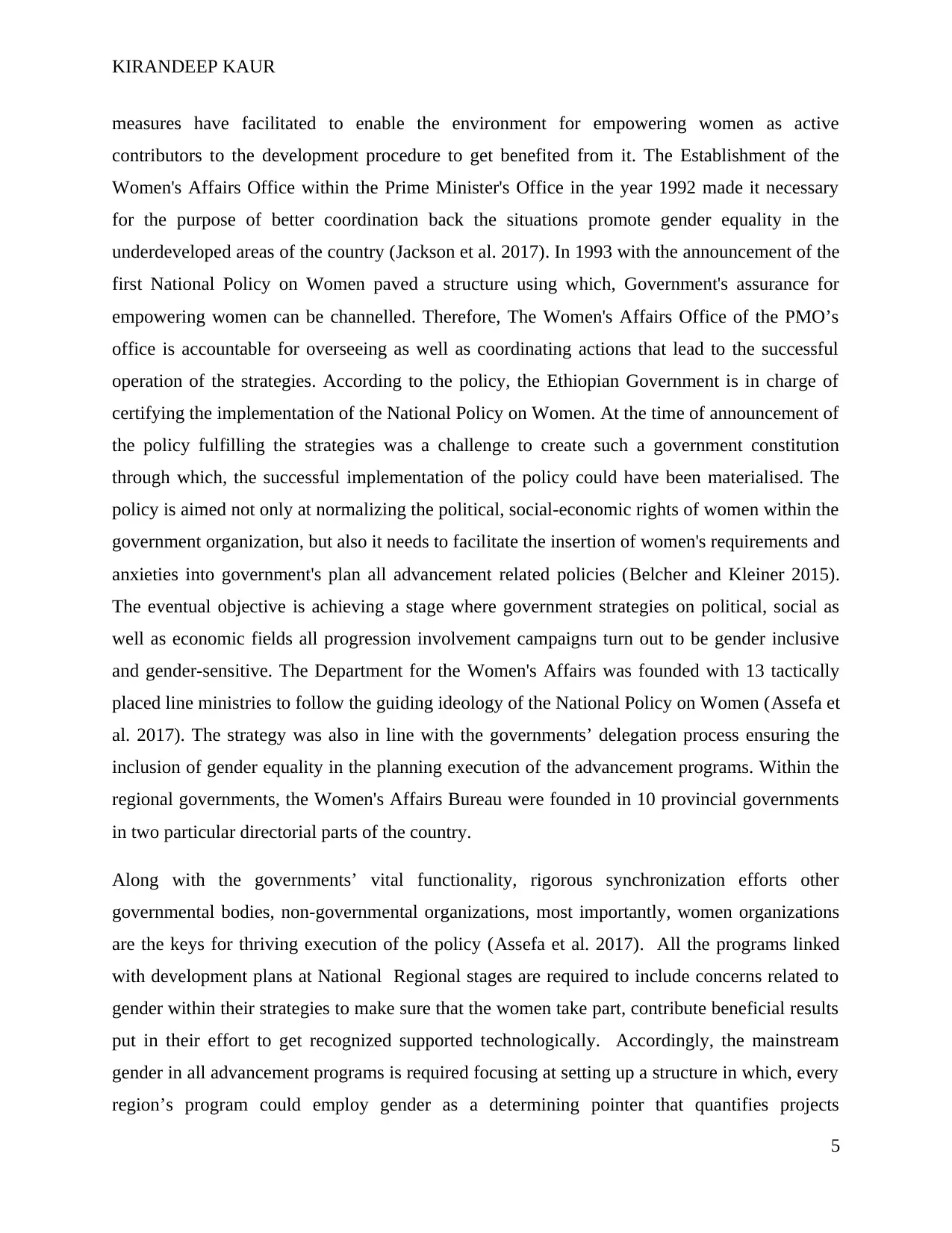
KIRANDEEP KAUR
measures have facilitated to enable the environment for empowering women as active
contributors to the development procedure to get benefited from it. The Establishment of the
Women's Affairs Office within the Prime Minister's Office in the year 1992 made it necessary
for the purpose of better coordination back the situations promote gender equality in the
underdeveloped areas of the country (Jackson et al. 2017). In 1993 with the announcement of the
first National Policy on Women paved a structure using which, Government's assurance for
empowering women can be channelled. Therefore, The Women's Affairs Office of the PMO’s
office is accountable for overseeing as well as coordinating actions that lead to the successful
operation of the strategies. According to the policy, the Ethiopian Government is in charge of
certifying the implementation of the National Policy on Women. At the time of announcement of
the policy fulfilling the strategies was a challenge to create such a government constitution
through which, the successful implementation of the policy could have been materialised. The
policy is aimed not only at normalizing the political, social-economic rights of women within the
government organization, but also it needs to facilitate the insertion of women's requirements and
anxieties into government's plan all advancement related policies (Belcher and Kleiner 2015).
The eventual objective is achieving a stage where government strategies on political, social as
well as economic fields all progression involvement campaigns turn out to be gender inclusive
and gender-sensitive. The Department for the Women's Affairs was founded with 13 tactically
placed line ministries to follow the guiding ideology of the National Policy on Women (Assefa et
al. 2017). The strategy was also in line with the governments’ delegation process ensuring the
inclusion of gender equality in the planning execution of the advancement programs. Within the
regional governments, the Women's Affairs Bureau were founded in 10 provincial governments
in two particular directorial parts of the country.
Along with the governments’ vital functionality, rigorous synchronization efforts other
governmental bodies, non-governmental organizations, most importantly, women organizations
are the keys for thriving execution of the policy (Assefa et al. 2017). All the programs linked
with development plans at National Regional stages are required to include concerns related to
gender within their strategies to make sure that the women take part, contribute beneficial results
put in their effort to get recognized supported technologically. Accordingly, the mainstream
gender in all advancement programs is required focusing at setting up a structure in which, every
region’s program could employ gender as a determining pointer that quantifies projects
5
measures have facilitated to enable the environment for empowering women as active
contributors to the development procedure to get benefited from it. The Establishment of the
Women's Affairs Office within the Prime Minister's Office in the year 1992 made it necessary
for the purpose of better coordination back the situations promote gender equality in the
underdeveloped areas of the country (Jackson et al. 2017). In 1993 with the announcement of the
first National Policy on Women paved a structure using which, Government's assurance for
empowering women can be channelled. Therefore, The Women's Affairs Office of the PMO’s
office is accountable for overseeing as well as coordinating actions that lead to the successful
operation of the strategies. According to the policy, the Ethiopian Government is in charge of
certifying the implementation of the National Policy on Women. At the time of announcement of
the policy fulfilling the strategies was a challenge to create such a government constitution
through which, the successful implementation of the policy could have been materialised. The
policy is aimed not only at normalizing the political, social-economic rights of women within the
government organization, but also it needs to facilitate the insertion of women's requirements and
anxieties into government's plan all advancement related policies (Belcher and Kleiner 2015).
The eventual objective is achieving a stage where government strategies on political, social as
well as economic fields all progression involvement campaigns turn out to be gender inclusive
and gender-sensitive. The Department for the Women's Affairs was founded with 13 tactically
placed line ministries to follow the guiding ideology of the National Policy on Women (Assefa et
al. 2017). The strategy was also in line with the governments’ delegation process ensuring the
inclusion of gender equality in the planning execution of the advancement programs. Within the
regional governments, the Women's Affairs Bureau were founded in 10 provincial governments
in two particular directorial parts of the country.
Along with the governments’ vital functionality, rigorous synchronization efforts other
governmental bodies, non-governmental organizations, most importantly, women organizations
are the keys for thriving execution of the policy (Assefa et al. 2017). All the programs linked
with development plans at National Regional stages are required to include concerns related to
gender within their strategies to make sure that the women take part, contribute beneficial results
put in their effort to get recognized supported technologically. Accordingly, the mainstream
gender in all advancement programs is required focusing at setting up a structure in which, every
region’s program could employ gender as a determining pointer that quantifies projects
5
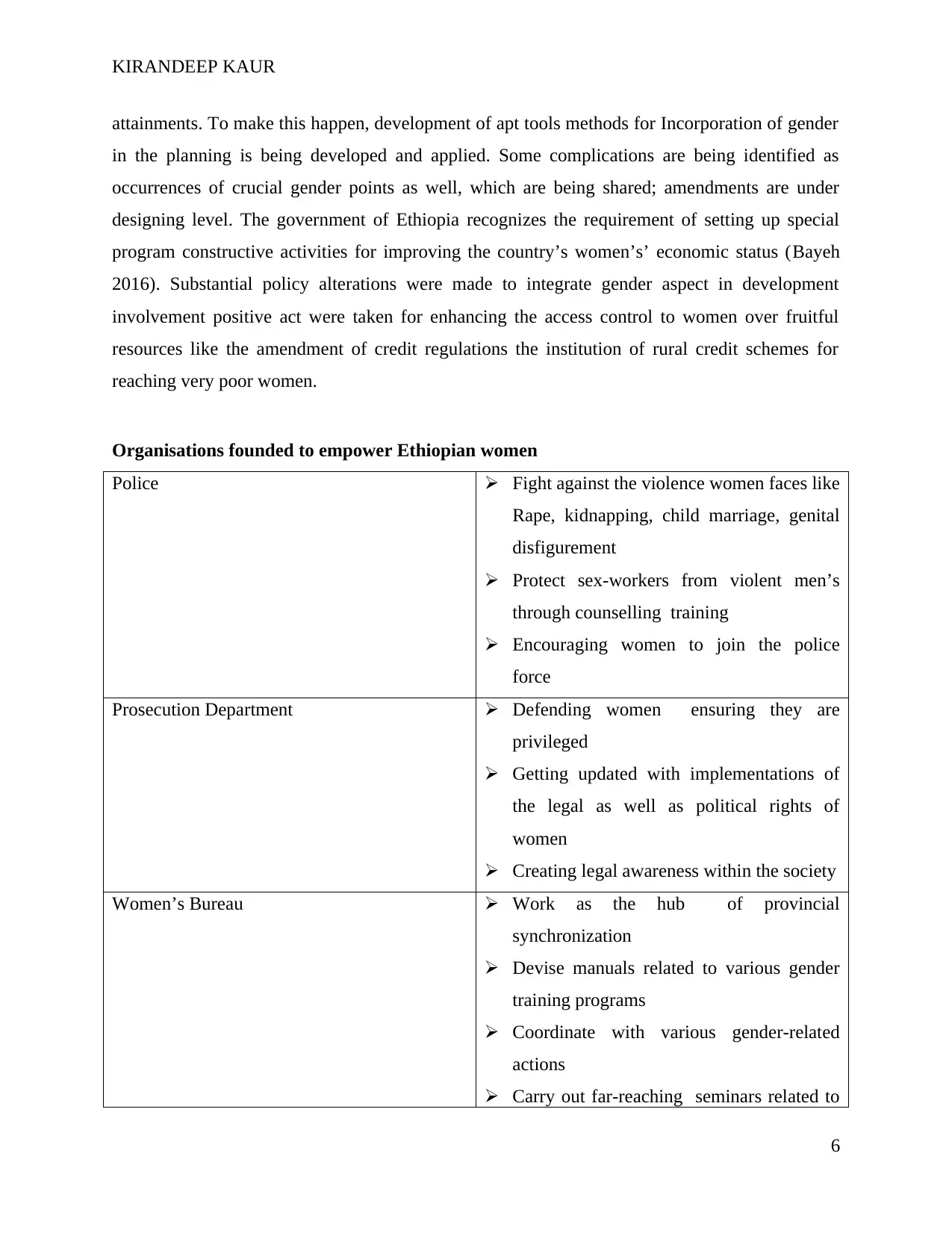
KIRANDEEP KAUR
attainments. To make this happen, development of apt tools methods for Incorporation of gender
in the planning is being developed and applied. Some complications are being identified as
occurrences of crucial gender points as well, which are being shared; amendments are under
designing level. The government of Ethiopia recognizes the requirement of setting up special
program constructive activities for improving the country’s women’s’ economic status (Bayeh
2016). Substantial policy alterations were made to integrate gender aspect in development
involvement positive act were taken for enhancing the access control to women over fruitful
resources like the amendment of credit regulations the institution of rural credit schemes for
reaching very poor women.
Organisations founded to empower Ethiopian women
Police Fight against the violence women faces like
Rape, kidnapping, child marriage, genital
disfigurement
Protect sex-workers from violent men’s
through counselling training
Encouraging women to join the police
force
Prosecution Department Defending women ensuring they are
privileged
Getting updated with implementations of
the legal as well as political rights of
women
Creating legal awareness within the society
Women’s Bureau Work as the hub of provincial
synchronization
Devise manuals related to various gender
training programs
Coordinate with various gender-related
actions
Carry out far-reaching seminars related to
6
attainments. To make this happen, development of apt tools methods for Incorporation of gender
in the planning is being developed and applied. Some complications are being identified as
occurrences of crucial gender points as well, which are being shared; amendments are under
designing level. The government of Ethiopia recognizes the requirement of setting up special
program constructive activities for improving the country’s women’s’ economic status (Bayeh
2016). Substantial policy alterations were made to integrate gender aspect in development
involvement positive act were taken for enhancing the access control to women over fruitful
resources like the amendment of credit regulations the institution of rural credit schemes for
reaching very poor women.
Organisations founded to empower Ethiopian women
Police Fight against the violence women faces like
Rape, kidnapping, child marriage, genital
disfigurement
Protect sex-workers from violent men’s
through counselling training
Encouraging women to join the police
force
Prosecution Department Defending women ensuring they are
privileged
Getting updated with implementations of
the legal as well as political rights of
women
Creating legal awareness within the society
Women’s Bureau Work as the hub of provincial
synchronization
Devise manuals related to various gender
training programs
Coordinate with various gender-related
actions
Carry out far-reaching seminars related to
6
⊘ This is a preview!⊘
Do you want full access?
Subscribe today to unlock all pages.

Trusted by 1+ million students worldwide
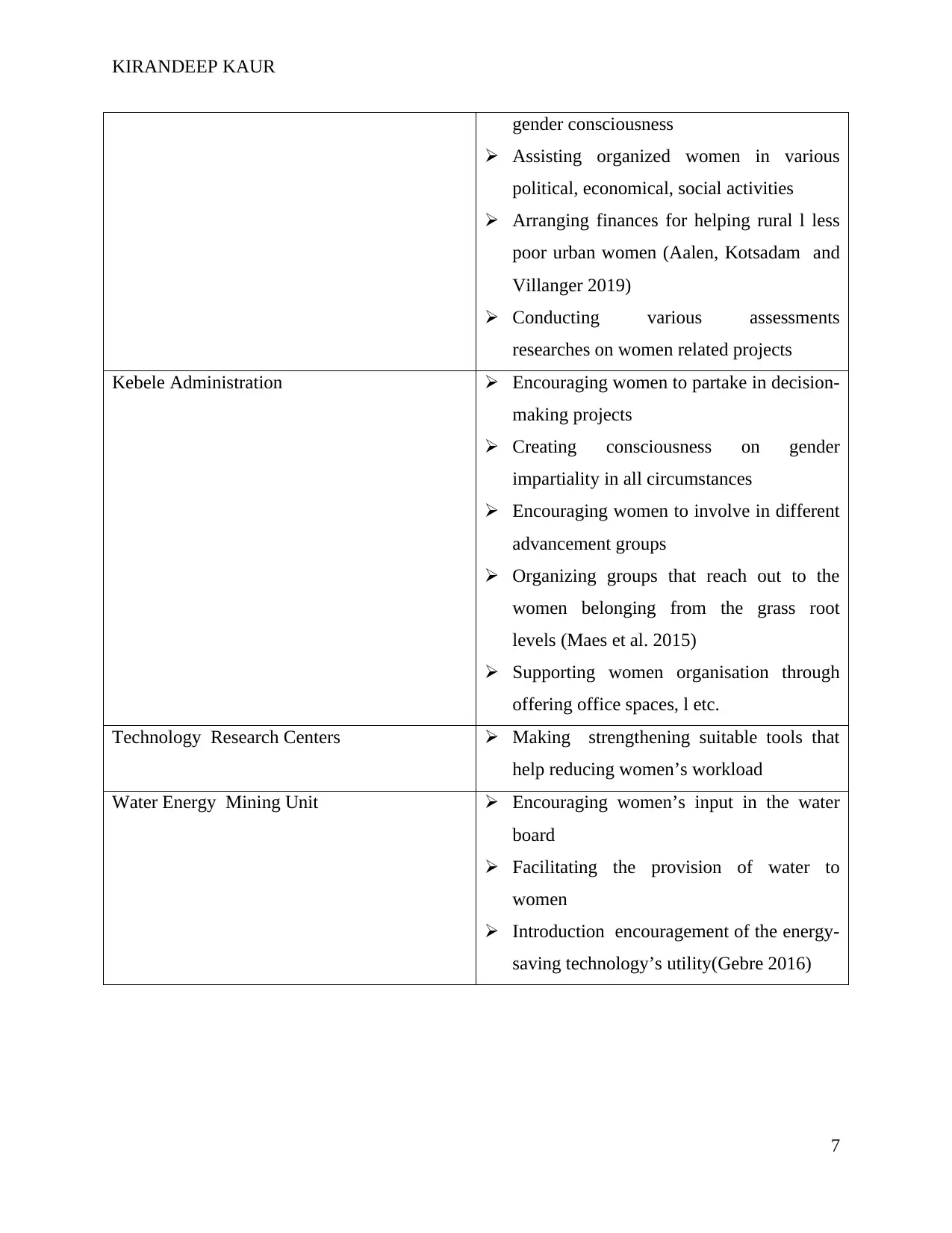
KIRANDEEP KAUR
gender consciousness
Assisting organized women in various
political, economical, social activities
Arranging finances for helping rural l less
poor urban women (Aalen, Kotsadam and
Villanger 2019)
Conducting various assessments
researches on women related projects
Kebele Administration Encouraging women to partake in decision-
making projects
Creating consciousness on gender
impartiality in all circumstances
Encouraging women to involve in different
advancement groups
Organizing groups that reach out to the
women belonging from the grass root
levels (Maes et al. 2015)
Supporting women organisation through
offering office spaces, l etc.
Technology Research Centers Making strengthening suitable tools that
help reducing women’s workload
Water Energy Mining Unit Encouraging women’s input in the water
board
Facilitating the provision of water to
women
Introduction encouragement of the energy-
saving technology’s utility(Gebre 2016)
7
gender consciousness
Assisting organized women in various
political, economical, social activities
Arranging finances for helping rural l less
poor urban women (Aalen, Kotsadam and
Villanger 2019)
Conducting various assessments
researches on women related projects
Kebele Administration Encouraging women to partake in decision-
making projects
Creating consciousness on gender
impartiality in all circumstances
Encouraging women to involve in different
advancement groups
Organizing groups that reach out to the
women belonging from the grass root
levels (Maes et al. 2015)
Supporting women organisation through
offering office spaces, l etc.
Technology Research Centers Making strengthening suitable tools that
help reducing women’s workload
Water Energy Mining Unit Encouraging women’s input in the water
board
Facilitating the provision of water to
women
Introduction encouragement of the energy-
saving technology’s utility(Gebre 2016)
7
Paraphrase This Document
Need a fresh take? Get an instant paraphrase of this document with our AI Paraphraser
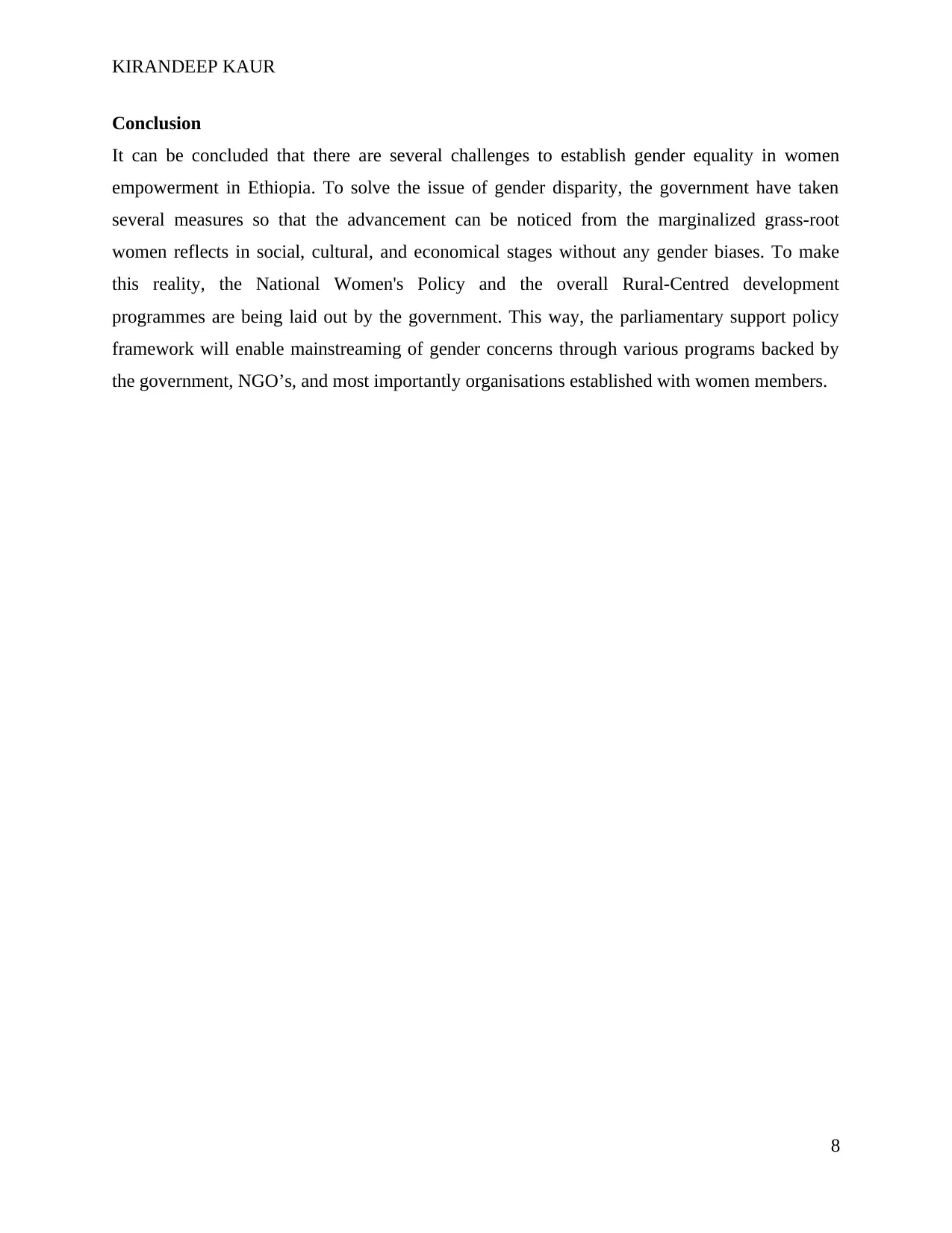
KIRANDEEP KAUR
Conclusion
It can be concluded that there are several challenges to establish gender equality in women
empowerment in Ethiopia. To solve the issue of gender disparity, the government have taken
several measures so that the advancement can be noticed from the marginalized grass-root
women reflects in social, cultural, and economical stages without any gender biases. To make
this reality, the National Women's Policy and the overall Rural-Centred development
programmes are being laid out by the government. This way, the parliamentary support policy
framework will enable mainstreaming of gender concerns through various programs backed by
the government, NGO’s, and most importantly organisations established with women members.
8
Conclusion
It can be concluded that there are several challenges to establish gender equality in women
empowerment in Ethiopia. To solve the issue of gender disparity, the government have taken
several measures so that the advancement can be noticed from the marginalized grass-root
women reflects in social, cultural, and economical stages without any gender biases. To make
this reality, the National Women's Policy and the overall Rural-Centred development
programmes are being laid out by the government. This way, the parliamentary support policy
framework will enable mainstreaming of gender concerns through various programs backed by
the government, NGO’s, and most importantly organisations established with women members.
8
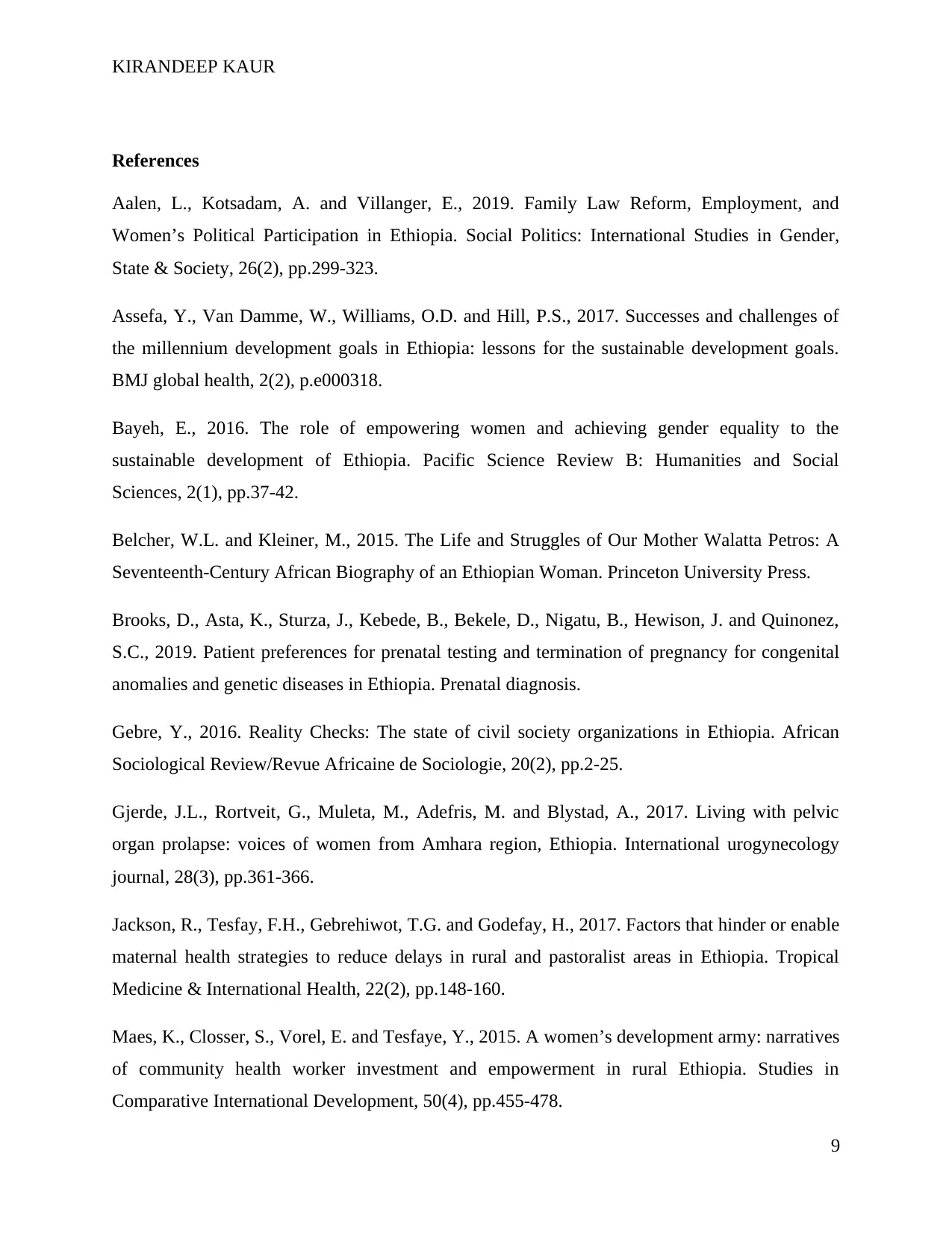
KIRANDEEP KAUR
References
Aalen, L., Kotsadam, A. and Villanger, E., 2019. Family Law Reform, Employment, and
Women’s Political Participation in Ethiopia. Social Politics: International Studies in Gender,
State & Society, 26(2), pp.299-323.
Assefa, Y., Van Damme, W., Williams, O.D. and Hill, P.S., 2017. Successes and challenges of
the millennium development goals in Ethiopia: lessons for the sustainable development goals.
BMJ global health, 2(2), p.e000318.
Bayeh, E., 2016. The role of empowering women and achieving gender equality to the
sustainable development of Ethiopia. Pacific Science Review B: Humanities and Social
Sciences, 2(1), pp.37-42.
Belcher, W.L. and Kleiner, M., 2015. The Life and Struggles of Our Mother Walatta Petros: A
Seventeenth-Century African Biography of an Ethiopian Woman. Princeton University Press.
Brooks, D., Asta, K., Sturza, J., Kebede, B., Bekele, D., Nigatu, B., Hewison, J. and Quinonez,
S.C., 2019. Patient preferences for prenatal testing and termination of pregnancy for congenital
anomalies and genetic diseases in Ethiopia. Prenatal diagnosis.
Gebre, Y., 2016. Reality Checks: The state of civil society organizations in Ethiopia. African
Sociological Review/Revue Africaine de Sociologie, 20(2), pp.2-25.
Gjerde, J.L., Rortveit, G., Muleta, M., Adefris, M. and Blystad, A., 2017. Living with pelvic
organ prolapse: voices of women from Amhara region, Ethiopia. International urogynecology
journal, 28(3), pp.361-366.
Jackson, R., Tesfay, F.H., Gebrehiwot, T.G. and Godefay, H., 2017. Factors that hinder or enable
maternal health strategies to reduce delays in rural and pastoralist areas in Ethiopia. Tropical
Medicine & International Health, 22(2), pp.148-160.
Maes, K., Closser, S., Vorel, E. and Tesfaye, Y., 2015. A women’s development army: narratives
of community health worker investment and empowerment in rural Ethiopia. Studies in
Comparative International Development, 50(4), pp.455-478.
9
References
Aalen, L., Kotsadam, A. and Villanger, E., 2019. Family Law Reform, Employment, and
Women’s Political Participation in Ethiopia. Social Politics: International Studies in Gender,
State & Society, 26(2), pp.299-323.
Assefa, Y., Van Damme, W., Williams, O.D. and Hill, P.S., 2017. Successes and challenges of
the millennium development goals in Ethiopia: lessons for the sustainable development goals.
BMJ global health, 2(2), p.e000318.
Bayeh, E., 2016. The role of empowering women and achieving gender equality to the
sustainable development of Ethiopia. Pacific Science Review B: Humanities and Social
Sciences, 2(1), pp.37-42.
Belcher, W.L. and Kleiner, M., 2015. The Life and Struggles of Our Mother Walatta Petros: A
Seventeenth-Century African Biography of an Ethiopian Woman. Princeton University Press.
Brooks, D., Asta, K., Sturza, J., Kebede, B., Bekele, D., Nigatu, B., Hewison, J. and Quinonez,
S.C., 2019. Patient preferences for prenatal testing and termination of pregnancy for congenital
anomalies and genetic diseases in Ethiopia. Prenatal diagnosis.
Gebre, Y., 2016. Reality Checks: The state of civil society organizations in Ethiopia. African
Sociological Review/Revue Africaine de Sociologie, 20(2), pp.2-25.
Gjerde, J.L., Rortveit, G., Muleta, M., Adefris, M. and Blystad, A., 2017. Living with pelvic
organ prolapse: voices of women from Amhara region, Ethiopia. International urogynecology
journal, 28(3), pp.361-366.
Jackson, R., Tesfay, F.H., Gebrehiwot, T.G. and Godefay, H., 2017. Factors that hinder or enable
maternal health strategies to reduce delays in rural and pastoralist areas in Ethiopia. Tropical
Medicine & International Health, 22(2), pp.148-160.
Maes, K., Closser, S., Vorel, E. and Tesfaye, Y., 2015. A women’s development army: narratives
of community health worker investment and empowerment in rural Ethiopia. Studies in
Comparative International Development, 50(4), pp.455-478.
9
⊘ This is a preview!⊘
Do you want full access?
Subscribe today to unlock all pages.

Trusted by 1+ million students worldwide

KIRANDEEP KAUR
Semela, T., Bekele, H. and Abraham, R., 2019. Women and Development in Ethiopia: A
Sociohistorical Analysis. Journal of Developing Societies, 35(2), pp.230-255.
10
Semela, T., Bekele, H. and Abraham, R., 2019. Women and Development in Ethiopia: A
Sociohistorical Analysis. Journal of Developing Societies, 35(2), pp.230-255.
10
1 out of 10
Your All-in-One AI-Powered Toolkit for Academic Success.
+13062052269
info@desklib.com
Available 24*7 on WhatsApp / Email
![[object Object]](/_next/static/media/star-bottom.7253800d.svg)
Unlock your academic potential
Copyright © 2020–2025 A2Z Services. All Rights Reserved. Developed and managed by ZUCOL.
